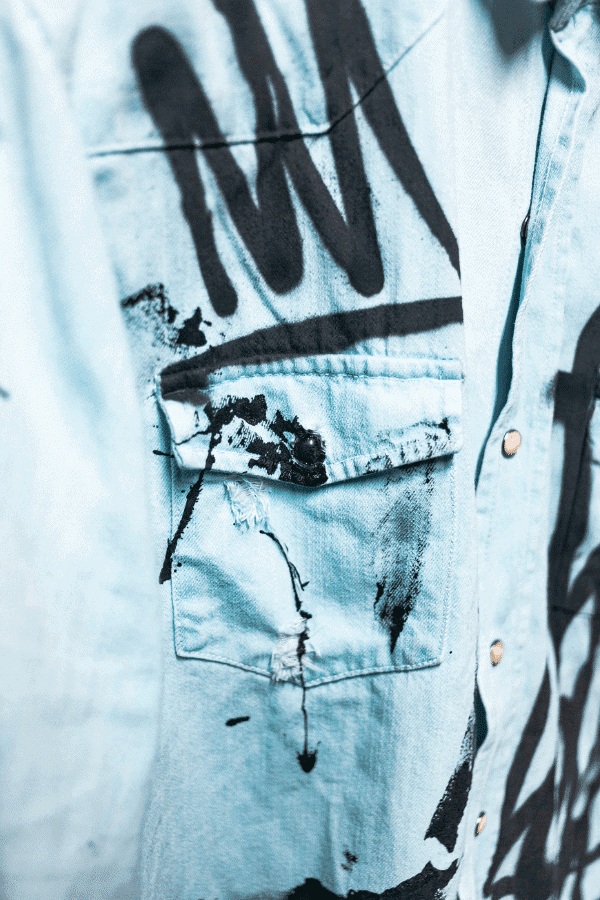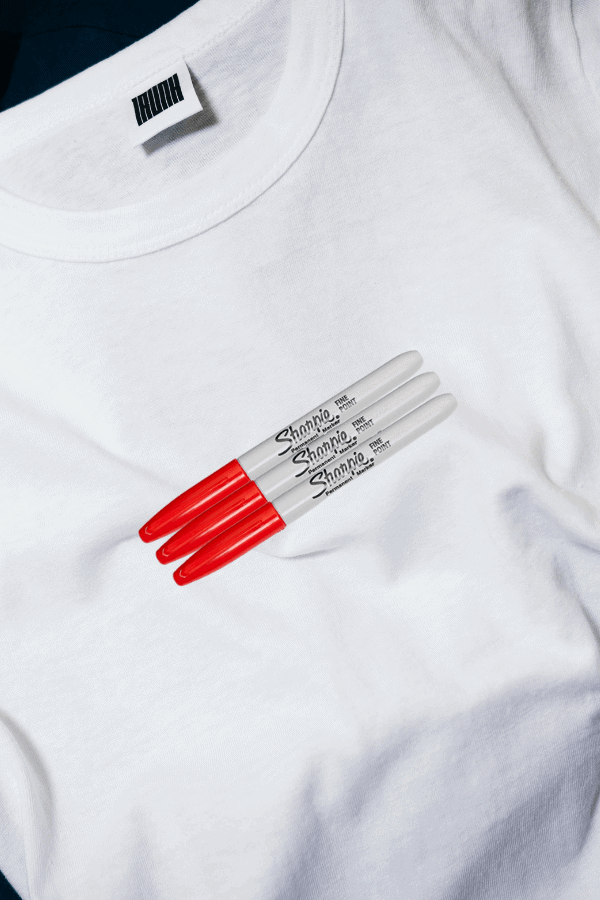Permanent markers are useful for a lot of activities, such as decorating T-shirts and labeling boxes.
While markers certainly have their benefits they can cause problems if they are allowed to leak onto clothing or fabric, which can be a particular problem if your kids get their hands on your markers.
Instead of throwing away your stained clothing, there are various ways that you can get Sharpie out of a variety of fabrics.
We will show you 6 great ways to remove permanent markers from clothing, many of which are things that you have around the home.
As an Amazon Associate, I earn from qualifying purchases. The links below may be affiliate links. Please read my disclosure policy for more information.

What is Sharpie Made Of?
Sharpies, a brand of permanent marker, are made of ink that is made up of xylene, toluene, and urethane resin. Propyl, butyl, and diacetone alcohol may also be present.
They are made to be fully or semi-permanent and can be used to make a variety of materials such as wood, ceramic, paper, and fabric. The ink in a Sharpie is composed of several different types of alcohol that carry color pigment in the solvents.
Does Sharpie Wash Out of Clothes?
As Sharpie forms a surface layer as opposed to staining the material it can be removed. Certain Sharpie stains will be easy to remove and some may take a little more elbow grease.
For the best chance of success, you should aim to get rid of the Sharpie stain when it is fresh as it is easier to remove than when it has had the chance to dry.
Once the item of clothing has been washed on the machine the Sharpie may ‘set’ which does make it more difficult to remove. That said, try not to worry if you are looking to remove old Sharpie stains as you can rescue your clothing.
Taking action on the stain as soon as you can is the first stage in removing Sharpie from your clothes and the second is to take a solvent that can help break down the ink and remove it from the item at hand.
It is not usually possible for Sharpie to be washed out of clothing by a standard washing machine cycle.
We will go on to talk about the six best solvents to remove permanent markers and the steps that you need to take to do so. Once the stain has been removed from the Sharpie you should wash it as normal with your regular laundry detergent.
[amazon box=”B0089PBTV2″ template=”vertical”]
How to Get Sharpie Out of Clothes: 6 Methods
Before you start with any of the methods below you should check the label on your item of clothing to ensure it is a safe method to use. You can also check out the label on the solvent to see if it mentions any materials that it should not be used on and also for any health and safety advice.
If there is a large Sharpie stain you may need to repeat the chosen process or try one of the other methods if the first one you try is not successful.
It is important that, while you can try more than one method, you should not mix any of the solutions as this may cause a toxic chemical reaction.
If there are no health and safety instructions on how to use a certain project then you may want to use a mask and gloves to protect your skin and respiratory system.
1. Rubbing Alcohol
The best way to remove Sharpie stains is to treat them with rubbing alcohol before washing them in the machine as normal. The rubbing alcohol is great at breaking down the polymers and alcohol in the ink of the permanent marker and can quickly have your clothes looking like there was never a mishap in the first place.
Steps:
- Pour the alcohol into a bowl
- Soak a clean cloth or a towel in the bowl
- Blot the Sharpie stain moving from the outside in. Be careful not to rub too harshly as it will push the stain into the clothing
- Wash clothing as normal and allow it to dry
2. Baking Soda
Another method that can help you get Sharpie from clothing is using a baking soda paste. This paste is made up of baking soda and water or you could use lemon juice, which can be particularly helpful if there is a large stain.
As the baking soda is alkaline it helps break up the oil that is present in the marker ink. If you are looking for a non-toxic cleaning solution baking soda is a great choice.
Steps
- Make up a mixture of 5 tablespoons of baking soda and water and stir well
- This is best done in a bowl as it will form a thick paste rather than a solution. You may need to add a little more water or baking powder if the mixture seems too runny or thick.
- The paste can be applied directly to the fabric and allowed to soak for up to 20 minutes or until it dries out.
- Once the mixture is dry it can be gently scrubbed away, taking the lipgloss away with it.
- Launder as usual
3. Vinegar
The natural acidity of vinegar makes for a great product for cleaning stains from fabric. You can use vinegar to remove Sharpie stains by using the following method.
Steps
- Mix 1 part water to 1 part distilled white vinegar in a container
- Leave for 10 minutes then spray onto the stained area using a clean spray bottle
- Dab the fabric with a clean towel dipped into the mixture following the same outside-to-inside method so that you don’t force the stain in further
- Rinse with a clean towel and water to remove reminder of the vinegar
- Wash as normal in the washing machine
4. Hairspray
Hairspray is another effective stain remover if you are wanting to remove Sharpie from your clothes. As hairspray contains alcohol it can remove stains if you do not have any rubbing alcohol at home. It is important to note that a lot of hairspray manufacturers are reducing the amount of alcohol in their products so some may not be as effective as others.
Steps
- Spray the hairspray directly onto the Sharpie stain
- Dab a clean towel or a cotton pad in a bowl of water
- Blot the stain moving from the outside so you do not force the ink stain into the clothing
- Wash clothing as normal and allow it to dry

5. Hydrogen Peroxide
Hydrogen peroxide works as bleach does to take out the color of the stain as opposed to removing them from the material. Hydrogen peroxide breaks up the molecular bonds between dye particles and solvents so it makes the Sharpie colorless.
This means that you will be left with areas of your clothing lighter than the rest so do test an inconspicuous area before applying a large amount to the Sharpie stain.
If you do see a mark or discoloring of the item you need to choose whether to live with the stain or create a unique design with the peroxide if you would simply end up throwing the stained clothes out anyway. You would not get the item restored to how it was before the stain occurred but you will have a new item of clothing!
Steps
- Place a thick protective padding behind the stain so that you do not stain any other areas of clothing or surfaces with the peroxide
- Take a clean towel (that you no longer need or find an old rag) and dab hydrogen peroxide onto it before wiping over the stain from the outside into the center. Repeat until the stain cannot be seen
- You may want to leave the hydrogen peroxide in for a few minutes before cleaning it off
- Rinse the stained area under cool running water
- If you do not see any Sharpie, go ahead and was clothing as normal
6. Nail Polish Remover
As acetone, if the main proponent of nail polish remover it can dissolve a lot of stains, including Sharpie. This solution can be very strong so it may not be the best for delicate or high-color clothing. You should test a small area to see how the material reacts before removing Sharpie from a large area.
Steps
- Place a thick protective padding behind the stain so that you do not stain any other areas of clothing or surfaces with the nail polish remover
- Dab a little nail polish at a time on a clean cloth and rub it into the fabric in a circular motion working front the outside.
- You should continue to dab and wipe until all of the Sharpie has been removed. You may need to reapply nail polish remover to the towel, using a stain-free area each time
- Wash the item of clothing in the washing machine as normal
By following one of the above 6 steps you should easily remove Sharpie from clothing without too much effort.



